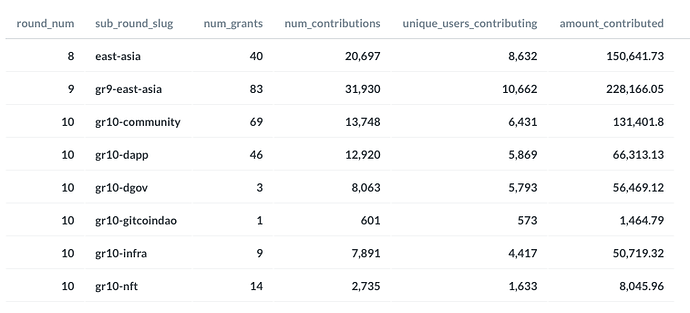Gitcoin GR11 Matching Pool Allocations 
Summary
This proposal looks to discuss and finalize how funding allocations from the Gitcoin Grants Round 11 Matching Pool are distributed. After a successful Grants round 10 proposal this proposal aims to continue to drive forward community owned decesions on Gitcoin Grants rounds.
Abstract
As previously outlined, the distribution of the Matching Pool to different Grants categories had previously been handled by the Gitcoin Core team (rounds 1-5), and later in consultation with the Funders League (rounds 6-9). Round 10 saw the first distribution based on GTC governance and we look to continue this with GR11.
The GR10 matching pool proposal saw over 2 million GTC vote on Snapshot, with over 1000 unique voters participating.
Motivation
Gitcoin Stewards and the wider community played a critical role in the governance and operation of GR10, and the move to this more decentralized organisational structure was fruitful in terms of increasing participation and ultimately getting more funding into the hands of those building for public goods.
Taking point on the governance of the Matching Pool allows Stewards and by proxy, the wider community to have a meaningful impact on the allocation of grants, without drastically altering the underlying foundation that has worked so well to date.
In GR10, the $700k matching pool was allocated as follows:
- Infrastructure: 30%
- Dapp Tech: 25%
- Community: 20%
- Latin America 10%
- NFTs: 7.5%
- dGov: 7.5%
There was also an additonal $50k side round added later via another Snapshot vote, to fund the ‘Gitcoin builds GitcoinDAO’ round.
Specification
Through discussion on this proposal and an eventual Snapshot vote, one of the following two options will be selected as the matching pool breakdown for Round 11.
Round 11 currently has $800k allocated to matching, though that may increase with the addition of new sponsors. The Gitcoin Core team has already signalled that there may be additional “side rounds” introduced during GR11 that will not use Matching Pool funds, and will be run during the round. These side rounds will bring additional funding to the round from unique sponsors like the Gitcoin building GitcoinDAO side round in GR10.
Option 1:
Distribute the matching pool based on the following breakdown. These allocations are proposed by the Gitcoin Core team alongside  _
_  .
.
- Infrastructure: 25%
- Dapp Tech: 25%
- Community: 20%
- NFT Tech: 10%
- dGov: 7.5%
- Africa: 7.5%
- Latin America: 5%
The goal of this new breakdown offers key aspects:
- Reduce the Latin America category to determine if that community can sustain development without as much regional support. This was done for the South East Asia round and is the last round we will directly support this region.
- Formally add the African region to jump start that community like we have done with the SE Asia region and LatAm region.
Option 2:
Gitcoin Stewards and wider community decide on a new matching breakdown. We encourage any Steward or community member to submit their own matching pool breakdown!
Please submit your proposal to the forum this week so that the community has sufficient time to vote before the round begins!
Benefits
- Continue to give GTC governance the power to ratify the direction of matching funds.
- Allow the community to have ownership over which pools receive the most matching.
Drawbacks
- Reduce convenience of distribution in favor of a more decentralized distribution process.
Vote
Once we have gathered feedback on both this and other proposals,  _
_  will gather all formal proposals and submit a Snapshot vote to decide which to move forward with.
will gather all formal proposals and submit a Snapshot vote to decide which to move forward with.
Please do not submit a snapshot vote for your proposal specifically! This just adds confusion and makes it harder for the community’s voice to be heard effectively.



